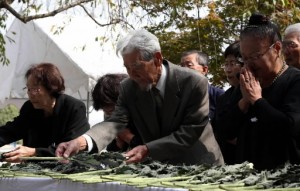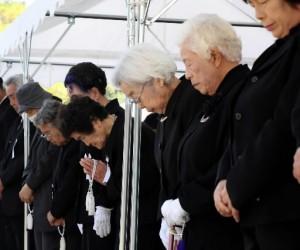Participants pray for peace at memorial ceremony for poison gas sufferers on Ohkunoshima Island
Oct. 30, 2015
by Satoshi Yamashita, Staff Writer
On October 22, a memorial ceremony dedicated to those who died after suffering from the effects of poison gas was held on Ohkunoshima Island in the city of Takehara, Hiroshima Prefecture. During World War II, a poison gas plant, operated by the former Imperial Japanese Army, was located on the island. About 120 people, including former workers and mobilized students at the plant, along with members of their families, attended the ceremony. In this year marking the 70th anniversary since the war ended, they renewed their opposition to war and prayed for the repose of the dead.
At the ceremony, registers holding the names of 3,730 people, including 74 who died over the past year, were placed in the cenotaph for the victims, and those in attendance offered a moment of silent prayer. Masaaki Shinmei, 84, the vice president of the confederation of groups which support the sufferers of the poison gas production on Ohkunoshima Island, concluded the ceremony by declaring, “Even today there are reports of poison gas being used in conflicts out in the world. We will convey the horror of war to the world and appeal for the elimination of nuclear arms and biological and chemical weapons.”
This is the 30th ceremony held by the confederation. Daiji Ito, 91, a resident of Suita, Osaka Prefecture, who was involved in making poison gas on the island, attended the ceremony for the first time and said in tears, “I recalled the faces of my coworkers and supervisors. I feel a duty to convey these facts to future generations on their behalf.”
The plant produced such chemical weapons as yperite gas and lewisite gas between 1929 and 1945. Even 70 years later, some people still suffer from the aftereffects of their involvement, including respiratory disorders.
A total of 87 former workers and mobilized students attended the memorial ceremony held on October 22 on Ohkunoshima Island. The ceremony was held to remember those who died as a result of their work at the poison gas factory on the island during World War II. Seventy years since the war ended, some vowed to continue conveying the damage caused by the poison gas as long as possible, while others expressed concern about maintaining their groups composed of aging sufferers and holding this ceremony in the future. With troubled hearts, they prayed before the cenotaph for the victims.
Some of the participants used canes or were helped by grandchildren as they walked to the ceremony. Coughing fits were heard, a consequence of exposure to poison gas. Family members of the victims are growing old as well. There were many empty seats at the venue.
Masaaki Shinmei, 84, the vice president of the confederation of support groups which organized the ceremony, said with unease, “It may be that, in the near future, this ceremony can’t be held any longer.”
People who worked at the poison gas plant are in possession of a health management booklet. According to the Atomic Bomb Survivors Support Division at at Hiroshima Prefectural Government, which also oversees issues involving the poison gas sufferers, the number of holders was 4,772 in fiscal 1987. In fiscal 2010, the total fell to 2,753, and now stands at 2,073. Some associations of A-bomb survivors have decided to dissolve their groups because the members have grown too elderly to maintain them. The average age of the A-bomb survivors is currently 80.13, while that of the poison gas sufferers is 88.
Mieko Hashimoto, 86, a member of the Ohkunoshima Setoda Shinbokukai Group located in Onomichi, Hiroshima Prefecture, stressed, “Our members are passing away year after year. Our time is limited, but we should do what we can to continue conveying our experiences.”
(Originally published on October 23, 2015)
On October 22, a memorial ceremony dedicated to those who died after suffering from the effects of poison gas was held on Ohkunoshima Island in the city of Takehara, Hiroshima Prefecture. During World War II, a poison gas plant, operated by the former Imperial Japanese Army, was located on the island. About 120 people, including former workers and mobilized students at the plant, along with members of their families, attended the ceremony. In this year marking the 70th anniversary since the war ended, they renewed their opposition to war and prayed for the repose of the dead.
At the ceremony, registers holding the names of 3,730 people, including 74 who died over the past year, were placed in the cenotaph for the victims, and those in attendance offered a moment of silent prayer. Masaaki Shinmei, 84, the vice president of the confederation of groups which support the sufferers of the poison gas production on Ohkunoshima Island, concluded the ceremony by declaring, “Even today there are reports of poison gas being used in conflicts out in the world. We will convey the horror of war to the world and appeal for the elimination of nuclear arms and biological and chemical weapons.”
This is the 30th ceremony held by the confederation. Daiji Ito, 91, a resident of Suita, Osaka Prefecture, who was involved in making poison gas on the island, attended the ceremony for the first time and said in tears, “I recalled the faces of my coworkers and supervisors. I feel a duty to convey these facts to future generations on their behalf.”
The plant produced such chemical weapons as yperite gas and lewisite gas between 1929 and 1945. Even 70 years later, some people still suffer from the aftereffects of their involvement, including respiratory disorders.
Aging poison gas sufferers feel time is running out to hand down experiences
A total of 87 former workers and mobilized students attended the memorial ceremony held on October 22 on Ohkunoshima Island. The ceremony was held to remember those who died as a result of their work at the poison gas factory on the island during World War II. Seventy years since the war ended, some vowed to continue conveying the damage caused by the poison gas as long as possible, while others expressed concern about maintaining their groups composed of aging sufferers and holding this ceremony in the future. With troubled hearts, they prayed before the cenotaph for the victims.
Some of the participants used canes or were helped by grandchildren as they walked to the ceremony. Coughing fits were heard, a consequence of exposure to poison gas. Family members of the victims are growing old as well. There were many empty seats at the venue.
Masaaki Shinmei, 84, the vice president of the confederation of support groups which organized the ceremony, said with unease, “It may be that, in the near future, this ceremony can’t be held any longer.”
People who worked at the poison gas plant are in possession of a health management booklet. According to the Atomic Bomb Survivors Support Division at at Hiroshima Prefectural Government, which also oversees issues involving the poison gas sufferers, the number of holders was 4,772 in fiscal 1987. In fiscal 2010, the total fell to 2,753, and now stands at 2,073. Some associations of A-bomb survivors have decided to dissolve their groups because the members have grown too elderly to maintain them. The average age of the A-bomb survivors is currently 80.13, while that of the poison gas sufferers is 88.
Mieko Hashimoto, 86, a member of the Ohkunoshima Setoda Shinbokukai Group located in Onomichi, Hiroshima Prefecture, stressed, “Our members are passing away year after year. Our time is limited, but we should do what we can to continue conveying our experiences.”
(Originally published on October 23, 2015)









